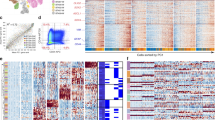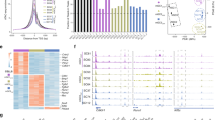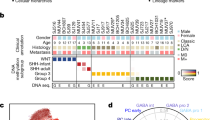Abstract
Tumor cells with stem cell-like properties can be cultured from human glioblastomas by using conditions that select for the expansion of neural stem cells. We generated cell lines from glioblastoma specimens with the goal to obtain model systems for glioma stem cell biology. Unsupervised analysis of the expression profiles of nine cell lines established under neural stem cell conditions yielded two distinct clusters. Four cell lines were characterized by the expression of neurodevelopmental genes. They showed a multipotent differentiation profile along neuronal, astroglial and oligodendroglial lineages, grew spherically in vitro, expressed CD133 and formed highly invasive tumors in vivo. The other five cell lines shared expression signatures enriched for extracellular matrix-related genes, had a more restricted differentiation capacity, contained no or fewer CD133+ cells, grew semiadherent or adherent in vitro and displayed reduced tumorigenicity and invasion in vivo. Our findings show that stable, multipotent glioblastoma cell lines with a full stem-like phenotype express neurodevelopmental genes as a distinctive feature, which may offer therapeutic targeting opportunities. The generation of another distinct cluster of cell lines showing similarly homogeneous profiling but restricted stem cell properties suggests that different phenotypes exist, each of which may lead to the typical appearance of glioblastoma.
This is a preview of subscription content, access via your institution
Access options
Subscribe to this journal
Receive 50 print issues and online access
$259.00 per year
only $5.18 per issue
Buy this article
- Purchase on Springer Link
- Instant access to full article PDF
Prices may be subject to local taxes which are calculated during checkout






Similar content being viewed by others
References
Al-Shahrour F, Diaz-Uriarte R, Dopazo J . (2004). FatiGO: a web tool for finding significant associations of Gene Ontology terms with groups of genes. Bioinformatics 20: 578–580.
Al-Shahrour F, Minguez P, Tarraga J, Montaner D, Alloza E, Vaquerizas JM et al. (2006). BABELOMICS: a systems biology perspective in the functional annotation of genome-scale experiments. Nucleic Acids Res 34: W472–W476.
Bao S, Wu Q, McLendon RE, Hao Y, Shi Q, Hjelmeland AB et al. (2006). Glioma stem cells promote radioresistance by preferential activation of the DNA damage response. Nature 444: 756–760.
Barrett T, Troup DB, Wilhite SE, Ledoux P, Rudnev D, Evangelista C et al. (2007). NCBI GEO: mining tens of millions of expression profiles—database and tools update. Nucleic Acids Res 35: D760–D765.
Beier D, Hau P, Proescholdt M, Lohmeier A, Wischhusen J, Oefner PJ et al. (2007). CD133(+) and CD133(−) glioblastoma-derived cancer stem cells show differential growth characteristics and molecular profiles. Cancer Res 67: 4010–4015.
Clarke MF, Dick JE, Dirks PB, Eaves CJ, Jamieson CH, Jones DL et al. (2006). Cancer stem cells—perspectives on current status and future directions: AACR Workshop on cancer stem cells. Cancer Res 66: 9339–9344.
Dahlstrand J, Zimmerman LB, McKay RD, Lendahl U . (1992). Characterization of the human nestin gene reveals a close evolutionary relationship to neurofilaments. J Cell Sci 103 (Part 2): 589–597.
de Hoon MJ, Imoto S, Nolan J, Miyano S . (2004). Open source clustering software. Bioinformatics 20: 1453–1454.
Doetsch F, Caille I, Lim DA, Garcia-Verdugo JM, Alvarez-Buylla A . (1999). Subventricular zone astrocytes are neural stem cells in the adult mammalian brain. Cell 97: 703–716.
Fan X, Matsui W, Khaki L, Stearns D, Chun J, Li YM et al. (2006). Notch pathway inhibition depletes stem-like cells and blocks engraftment in embryonal brain tumors. Cancer Res 66: 7445–7452.
Galli R, Binda E, Orfanelli U, Cipelletti B, Gritti A, De Vitis S et al. (2004). Isolation and characterization of tumorigenic, stem-like neural precursors from human glioblastoma. Cancer Res 64: 7011–7021.
Glaser T, Perez-Bouza A, Klein K, Brustle O . (2005). Generation of purified oligodendrocyte progenitors from embryonic stem cells. FASEB J 19: 112–114.
Gritti A, Parati EA, Cova L, Frolichsthal P, Galli R, Wanke E et al. (1996). Multipotential stem cells from the adult mouse brain proliferate and self-renew in response to basic fibroblast growth factor. J Neurosci 16: 1091–1100.
Hemmati HD, Nakano I, Lazareff JA, Masterman-Smith M, Geschwind DH, Bronner-Fraser M et al. (2003). Cancerous stem cells can arise from pediatric brain tumors. Proc Natl Acad Sci USA 100: 15178–15183.
Holash J, Maisonpierre PC, Compton D, Boland P, Alexander CR, Zagzag D et al. (1999). Vessel cooption, regression, and growth in tumors mediated by angiopoietins and VEGF. Science 284: 1994–1998.
Ignatova TN, Kukekov VG, Laywell ED, Suslov ON, Vrionis FD, Steindler DA . (2002). Human cortical glial tumors contain neural stem-like cells expressing astroglial and neuronal markers in vitro. Glia 39: 193–206.
Kageyama R, Ohtsuka T . (1999). The Notch–Hes pathway in mammalian neural development. Cell Res 9: 179–188.
Kanehisa M, Goto S, Kawashima S, Okuno Y, Hattori M . (2004). The KEGG resource for deciphering the genome. Nucleic Acids Res 32: D277–D280.
Kondo T, Setoguchi T, Taga T . (2004). Persistence of a small subpopulation of cancer stem-like cells in the C6 glioma cell line. Proc Natl Acad Sci USA 101: 781–786.
Kunkel P, Ulbricht U, Bohlen P, Brockmann MA, Fillbrandt R, Stavrou D et al. (2001). Inhibition of glioma angiogenesis and growth in vivo by systemic treatment with a monoclonal antibody against vascular endothelial growth factor receptor-2. Cancer Res 61: 6624–6628.
Lee J, Kotliarova S, Kotliarov Y, Li A, Su Q, Donin NM et al. (2006). Tumor stem cells derived from glioblastomas cultured in bFGF and EGF more closely mirror the phenotype and genotype of primary tumors than do serum-cultured cell lines. Cancer Cell 9: 391–403.
Liu G, Yuan X, Zeng Z, Tunici P, Ng H, Abdulkadir IR et al. (2006). Analysis of gene expression and chemoresistance of CD133+ cancer stem cells in glioblastoma. Mol Cancer 5: 67.
Ohgaki H, Kleihues P . (2007). Genetic pathways to primary and secondary glioblastoma. Am J Pathol 170: 1445–1453.
Phillips HS, Kharbanda S, Chen R, Forrest WF, Soriano RH, Wu TD et al. (2006). Molecular subclasses of high-grade glioma predict prognosis, delineate a pattern of disease progression, and resemble stages in neurogenesis. Cancer Cell 9: 157–173.
Piccirillo SG, Reynolds BA, Zanetti N, Lamorte G, Binda E, Broggi G et al. (2006). Bone morphogenetic proteins inhibit the tumorigenic potential of human brain tumour-initiating cells. Nature 444: 761–765.
Pilkington GJ . (2005). Cancer stem cells in the mammalian central nervous system. Cell Prolif 38: 423–433.
Ranscht B, Clapshaw PA, Price J, Noble M, Seifert W . (1982). Development of oligodendrocytes and Schwann cells studied with a monoclonal antibody against galactocerebroside. Proc Natl Acad Sci USA 79: 2709–2713.
Shih AH, Holland EC . (2006). Notch signaling enhances nestin expression in gliomas. Neoplasia 8: 1072–1082.
Singh SK, Clarke ID, Terasaki M, Bonn VE, Hawkins C, Squire J et al. (2003). Identification of a cancer stem cell in human brain tumors. Cancer Res 63: 5821–5828.
Singh SK, Hawkins C, Clarke ID, Squire JA, Bayani J, Hide T et al. (2004). Identification of human brain tumour initiating cells. Nature 432: 396–401.
Svendsen CN, ter Borg MG, Armstrong RJ, Rosser AE, Chandran S, Ostenfeld T et al. (1998). A new method for the rapid and long term growth of human neural precursor cells. J Neurosci Methods 85: 141–152.
Taylor MD, Poppleton H, Fuller C, Su X, Liu Y, Jensen P et al. (2005). Radial glia cells are candidate stem cells of ependymoma. Cancer Cell 8: 323–335.
Tunici P, Bissola L, Lualdi E, Pollo B, Cajola L, Broggi G et al. (2004). Genetic alterations and in vivo tumorigenicity of neurospheres derived from an adult glioblastoma. Mol Cancer 3: 25.
Tusher VG, Tibshirani R, Chu G . (2001). Significance analysis of microarrays applied to the ionizing radiation response. Proc Natl Acad Sci USA 98: 5116–5121.
Vescovi AL, Galli R, Reynolds BA . (2006). Brain tumour stem cells. Nat Rev Cancer 6: 425–436.
Wu Z, Irizarry RA, Gentleman R, Martinez-Murillo F, Spencer F . (2004). A model-based background adjustment for oligonucleotide expression arrays. J Am Stat Assoc 99: 909–917.
Yuan X, Curtin J, Xiong Y, Liu G, Waschsmann-Hogiu S, Farkas DL et al. (2004). Isolation of cancer stem cells from adult glioblastoma multiforme. Oncogene 23: 9392–9400.
Zhang QB, Ji XY, Huang Q, Dong J, Zhu YD, Lan Q . (2006). Differentiation profile of brain tumor stem cells: a comparative study with neural stem cells. Cell Res 16: 909–915.
Acknowledgements
We thank Professor Dr Christian Hagel for access to neuropathological information and to viewing tumor slides. We also thank Regina Fillbrandt, Svenja Zapf and Dorothea Zirkel for expert technical assistance and Steve Guerrero and Pete Haverty for their advice and assistance in analysis of SNP chip data. KL and MW are supported by the Deutsche Forschungsgemeinschaft (LA1300/3-1) and by the Erich und Gertrud Roggenbuck-Stiftung. HG is supported by a scholarship of the FAZIT-Stiftung. Material funds were generously provided by the Rudolf-Bartling-Stiftung and the Georg and Jürgen Rickertsen Stiftung.
Author information
Authors and Affiliations
Corresponding author
Additional information
Supplementary Information accompanies the paper on the Oncogene website (http://www.nature.com/onc).
Rights and permissions
About this article
Cite this article
Günther, H., Schmidt, N., Phillips, H. et al. Glioblastoma-derived stem cell-enriched cultures form distinct subgroups according to molecular and phenotypic criteria. Oncogene 27, 2897–2909 (2008). https://doi.org/10.1038/sj.onc.1210949
Received:
Revised:
Accepted:
Published:
Issue Date:
DOI: https://doi.org/10.1038/sj.onc.1210949
Keywords
This article is cited by
-
CircNDC80 promotes glioblastoma multiforme tumorigenesis via the miR-139-5p/ECE1 pathway
Journal of Translational Medicine (2023)
-
Protective effect of bone morphogenetic protein-7 induced differentiation of bone marrow mesenchymal stem cells in rat with acute spinal cord injury
Functional & Integrative Genomics (2023)
-
If Artificial In Vitro Microenvironment Can Influence Tumor Drug Resistance Network via Modulation of lncRNA Expression?—Comparative Analysis of Glioblastoma-Derived Cell Culture Models and Initial Tumors In Vivo
Cellular and Molecular Neurobiology (2022)
-
Co-expression of cancer driver genes: IDH-wildtype glioblastoma-derived tumorspheres
Journal of Translational Medicine (2020)
-
Genomic evolution of cancer models: perils and opportunities
Nature Reviews Cancer (2019)



